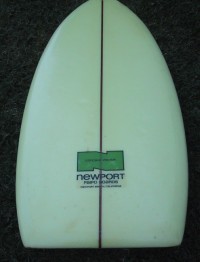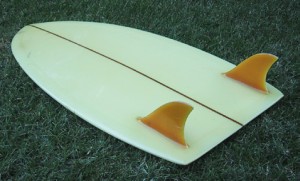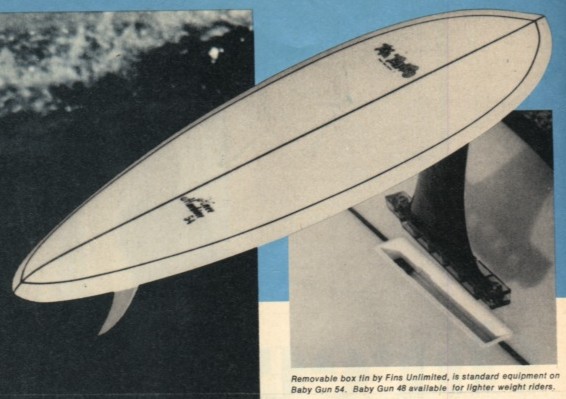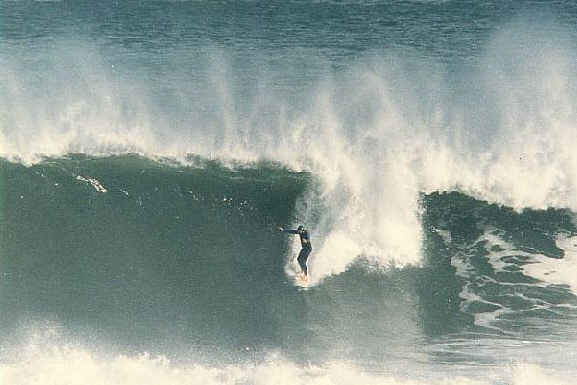Paipo Interview with John "Doc" Milliken
December 5, 2009 - Cape Cod, Massachusetts (USA)
Questions and e-mail interview by Bob Green
1. Did you start surfing on the East Coast? When and where was this?
I
did, on Cape Cod in the late 1960s. To be exact... well, it's been long
enough that I don't remember exactly when. Old, heavy, clunky
longboards borrowed from a surf shop which was in the back of a gas
station I worked at when I was (roughly) twelve years old. Then, I
started to use a Newport Paipo Concave Vector the shop owned, and had
the long-term use of it all one winter... and I was hooked. Paipos were
fun, longboards were just logs. Heavy, ugly, nonperforming logs.
2. I read you were about 14 when you got your first board and that you still may have this board. Was this a stand-up board?
Uhmmm-
the first board I owned, as opposed to borrowing, was a 5'x19" Gordon
and Smith, which was built as a kneeboard but I used it as a paipo
until I got my act a little more together. I still have it, and
somewhere I have photos.
3. What got you into kneeboards?
You
know, I kinda wonder about that myself, now. It was around 1970, or a
little earlier. Greenough was by far the most advanced guy surfing.
Kneeboards were different than the common herd and I was intentionally
different myself. Plus, they went like hell and could do things
surfboards couldn't do. So, I went for it.
And kneeboarders, at least then, were the techno-intellectuals of
surfing, which appealed to me. I hadn't heard of Terry Hendricks then,
but it's unsurprising that people like him were well represented in the
kneelo crew. Similarly, on the 'net, kneelos and other alternative
forms were disproportionately represented... just a more techno bunch.
4. What has been your involvement in bellyboards/paipos?
Uhmmmm-
user, half-baked theorist, if I had a decent one I'd be back on them.
Though I have to confess that I'd again be looking for something like
the Newport Paipo, or something at the technological edge. Middle of
the road stuff, well, it's never been fun for me. Bodyboards, for
instance, have zero appeal to me.
5. How long have you been involved in running a surfshop?
Just under 40 years as a hanger-on, over 30 working there. Which all ended a couple of years back. It was time, I guess.
6. No doubt you've seen lots of fads and had plenty of feedback about what works and what doesn't?
Fads by... well, if not the dozen, at least many. Few of which were functional.
7.
In addition to homemade balsa or ply boards and boards from Hawaii,
were bellyboards being made on the East Coast? If so, who was making
and riding them?
Good
question. Plywood paipos really didn't show up here, nor did balsas.
But then, our surf era didn't really gain traction until, oh, 1964-65
lets say. Some must have been made here, cut-down longboards and the
like or one or two made by regular manufacturers (and there were
several out here) but I can't really recall seeing them in any detail.
8. The 60s-70s saw a number of commercially produced bellyboards such
as El Paipo, Newport Paipo, Hansen, Dextra, and Jacks. What are your
views on why these boards were produced? Was there a market or was it
marketing?
Good
question. They saw a market for something (I think) that could be used
with a short learning curve and could be sold cheap. At least, that was
Hansen, Dextra and Jacks. The latter two were definitely selling to the
lowest bidder. Same for (I seem to recall) Surfboards by The Greek, who
I believe made a few and advertised them in the magazines. Pretty much
all of those were attempting to sell anything that anybody was willing
to buy.
El Paipo and Newport Paipo were different. Not the cobby,
mini-surfboard-like things that Hansen et al were making but distinct
paipo shapes. Not round railed, not the same center fin setup that was
basically a smaller glass surfboard fin. E-P and N-P were made by paipo
guys for paipo guys, at least that's my take on it.
9.
What do you know about who owned the companies, shaped/designed these
boards, the volumes sold and how long they were produced for?
Uhmmm
- I can't really tell you much about that. I knew a little at one time
but long since forgot it. On the other hand, I know who would know, and
that's Ron Romanoski. He worked for Newport Paipo and I think worked
for El Paipo, too.
The last I really saw of Newport Paipo and El Paipo was around the
first twin-fins. They were trying very hard to do a crossover market
with boards in the 5'4" range like the Newport Paipo Shoe... which
didn't work especially well, and the El Paipo equivalent was a dog,
spun out easily and plain didn't work. Around then, too, was when Tom
Morey got clear of Morey Pope and started doing boogie boards, and
those undercut the paipo/kneeboard market to where it is now.
10.
What do you think about how these boards respectively rode? Why did they stop being produced?
Ahmmmm-
the earlier Newport Paipos were pretty good, some of the El Paipos were
interesting at least. The others you mention were, comparatively
speaking, dogs. Performance and edge holding were pretty worthless.
11.
You've written that there are two definite things about a paipo: "edge
control is a major thing in successful paipo and they work best on
hollow, fast waves." What design features enhance speed in a paipo? How
can you maximise speed when surfing a paipo?
Okay,
a little side trip into physics plus a hiccup or two of Naval
Architecture/Marine Engineering; A paipo is a relatively small planing
surface. But it's loaded relatively heavily. By way of planing hull
design, the more power you put to a planing hull (weights remaining
constant ) the more lift you get per unit area.
Now, taking that along, the paipo (and its cousin the kneeboard) have a
theoreticly higher top speed (I'll oversimplify with 'lower surface
area = less friction = higher top speed'), but also a higher stall
speed, that is the speed at which the small planing area fails to
generate enough lift for the thing to plane at all.
So, what I said was that hollow, fast waves are pretty much a necessity
for paipos (and kneeboards) and that you need good edge control. Going
back to the power required to push the paipo at a plane: what you have
is pretty much MG * sinW, where MG is the mass of the board-rider unit
multiplied by gravity and that in turn multiplied by the sine of the
angle the board-rider unit are headed down: the wave face, which I have
called W. The component of power produced by the motion of the wave
itself is pretty much something that can be ignored.
Vertical wave face? Sin W goes to 1, maximum power and thus maximum
speed. Bare roller-type swells, sin W is pretty low, no power available
and the paipo won't go.
Okay, but... you can't just be going straight down the wave. Instead,
you're at an angle along the wave face. The steeper the better, for
maximum power available and thus maximum speed..... and maximum fun.
But, to hold that edge skittering along a near-vertical wave face, you
gotta have an edge that will hold. The thick round-railed Dextras,
Hansens and their ilk wouldn't do it, but plywood will, or a thin
down-railed edge on a well made foam paipo (or kneeboard) like the
Newport Paipos. And, as I recall, the El Paipos were not nearly as
sophisticated that way as the Newports, at least not early on. Romo
would know better than me.
12. What are your thoughts about flex in paipo, kneeboards and mats?
I
think it's a very good idea and where the bodyboard people lost sight
of what made the original Morey Boogies such successful surfcraft.
Rocker, on a non-flexing board, is always a compromise. The bottom
doesn't conform to the water surface of the wave when planing, at least
not entirely, so drag goes up. Kind of like how the Space Shuttle or
other lifting-body aircraft come in at low speed, the angle of attack
is kinda high, trading off drag for increased lift.
On the other hand, a flexible bottom kneeboard...or paipo, or mat, it
conforms to the curved water surface of the wave face, lowering drag
considerably. In a hard turn, you're not dragging a stick through the
water for all intents and purposes, you're using something that flexes
into the turn, conforming to the waterflow much better and losing less
energy in that turn. 'Cos in a turn on a surfcraft, you are trading off
momentum and speed as you turn, until you pick up a new line down the
wave and start accelerating again.
Now, I should also say that this and the 'edge control and wave power'
things that preceded it are massive oversimplifications. They'll do as
short explanations, but the reality of it is much more complex.
13. You've said fins cause drag what design features might compensate for this in a bellyboard/paipo?
Well,
minimize the fins, anyhow. Terry Hendricks has said (and I agree) that
fins are not especially necessary in a paipo, it can all be done with
the rails. There have been a whole lot of very successful paipos that
were no more than pieces of finless plywood, held on down the line by
the edges.
14. What are your thoughts about buoyancy and paipo performance?
Uhmmm
- to paraphrase the Borg, 'Buoyancy is Futile.' The idea of the paipo
is, really, to be a better planing area than bodysurfing. But with the
same intimacy and more speed, controllability and to allow more of the
wave to be used than you could with just the rather oddly shaped human
body as a planing surface. At least that's my take on the essence of
using a paipo.
But, if you're working that tight to the steepest part of a wave,
buoyancy can be a hindrance. You need to go deep fast and easy.
Catching waves very steep/very late, well, buoyancy doesn't help.
15. Hulls, mini-Simmons and paipo? Any comments?
Uhmmmm - bear in mind that I am a half-assed, incompletely trained Naval Architect/Marine Engineer, so I have Opinions......
Hulls...ain't any more or less hulls than board with flat bottoms or
concave bottoms. What they are is convex planing surfaces, like the
'skimming dish' sailboats of times past. Can they be used profitably as
paipos? Sure, though as the angle of bottom to edge changes you have
less edge holding ability and this in turn detracts from the function
of the thing.
Mini-Simmons - I'll confess that I don't know much about these beyond
thinking that Simmons himself might have disowned them. Simmons was an
interesting cat, Caltech -trained, he was the kind of guy who studied
and Did the Math. Unlike Greenough, but very much like that
other Caltech-trained innovator, Terry Hendricks. An iconoclast, if
he'd been around twenty years later it might have been him and not
Greenough who was the kneeboard ideal. I am pretty certain that Simmons
wouldn't be going backwards, he'd be tank testing things with damned
clever gear.
Paipos... should have as little to do as possible with mainstream
surfboard design theory. First off, most of mainstream surf theory is
akin to astrology in its relationship to real science and engineering.
Next, paipos ain't the same thing as a surfboard. They plane
differently, weight loading and accelerations are different,
turning/controlling 'em is different. Paipos cannot and should not
follow surfboards, it should be the other way around.
16.
By weight loading - do you mean the weight distribution of the surfer?
Can you to elaborate on your comment regarding the difference between
paipo and surfboard design?
Let's
see- yes, that plus how weight transfer is used for turning and what
have you. Consider a surfboard with the sort of usable flex that you'd
get on a flex paipo or kneeboard. First time somebody stood on it, it'd
turn into a banana or more like a "U". Surfboards have effectively
single point loads.
The center of mass of a surfboard-surfer unit is up pretty high, so
that the inertia and momentum are centered higher too. Might be able to
put more force into a turn... if someone had amazing traction and very
strong ankles.... but there's drawbacks. The pivoting forces that a
stand-up can use are not present in paipos at all and to a much lesser
degree in kneeboards.
17.
Also, is there anything more that you want to say about paipo design
theory, especially in relation to the factors you mention in the above
quote?
If
you go with a paipo that's a scaled down surfboard, well, it's
essentially like the old Dextra paipos, a horribly inefficient way of
prone riding. On the other hand, take my old steed, the Concave Vector - note the rails, note how the planing surface does no more and no less than give optimal planing.
Newport Paipo Concave Vector

|

Length: 40 3/4"
Nose width: 16 1/2" and Tail width: 20"
Tickness: 1 1/4"
|
Source: Vagabondsurf.com (see more information on the Concave Vector).
|
Similarly
- see the steps in the right direction and steps off the path the
various makers had..... like the El Paipo 54" mistake.
El Paipo Knee Machine 54

Source: Vagabondsurf.com (see more information paipos from this period).
18. Did you ever build a paipo based on John Galera's specifications? If so, how did it go?
I haven't, yet, but there is a great deal of potential there, either as a paipo or as a flex kneeboard.
19. If you were to make a bellyboard for yourself, what would it be? What would it be made of?
Excellent
question, that. Depend a lot on what I wanted it to do. Flex, for
instance? Okay, that's very different than how you'd want to build
something that was a planing hull. Terry Hendricks has built a
successful hydrofoil bodyboard, though it's more a paipo than a
bodyboard. The possibilities are fascinating.
20. Do you see any bellyboards/paipos being surfed?
Yes, but few made or surfed competently, more are hacks doing hack jobs.
21. Any particular surf or waves stand out that you rode a bellyboard in?
Big,
cold winter waves here, with real power. Doing drops that were on the
skittering edge of disaster but making it and drawing long, long lines
as fast as I could possibly go. Was and still remains my idea of 'pure
paipo' use and pure surfing enjoyment. Like this below, at one of my
local breaks.

Source: http://fbates.home.comcast.net/~fbates/ohead.jpg
22. What has been the attraction of riding prone craft?
Ah
- intimacy with the wave, intimacy with the forces involved, the
sensation of speed and power. Those jokers on SUPs haven't a clue and
never will.
23. Your website contains two stories. I bet you could tell a few more than two stories? Did you get any feedback about how the sex-wax went?
Haaa-
she never showed up. The thing I learned in 40 years in and around the
surf biz is this. Surfers suck.... but there are a lot of very
interesting people who happen to surf. That's why I stayed in the
business and in surfing, the interesting people.
24. You seem to have a broad knowledge and range of practical skills, what else are you into besides surfing?
Heh
- my one grandfather was trained as three kinds of engineer and ran a
company making Rayon, first one that there ever was. And he was neither
a textile engineer nor a chemical engineer, but he could lay out what
they'd do and do it well. My other grandfather was a man who could make
or fix anything. Unschooled, but great practical knowledge and a feel
for how things worked.
By comparison, I'm not much. However, an idea of what I have going on right now:
- Boat repair on two boats, including sail and other canvas work. I am, after all, a trained boatbuilder, it's my basic trade.
- Growing shellfish: aquaculture.
- Developing
new methods and gear for growing at least three separate shellfish
species. I have enough engineering training that in some ways I think I
can make some real contributions.
- Teaching shellfish aquaculture for the local county extension service.
- Sitting
on a regional committee that gives out several hundred thousand dollars
a year in research money for the aquaculture industry, funded by the
U.S. Department of Agriculture.
- I
have to write a little software sometime soon, a kind of
macro-from-hell for MS Outlook that will auto-respond to a
RSS/XML/XHTML message with the proper responses and send it out at a
variable/random time delay between two specified response times. Plus
writing the manual.
- Writing
history - a history of a local estuary, actually, with some geology and
tech history thrown in. My great aunt wrote the history of the town I
live in ( and that my family had a part in starting, back around 1640)
and she got me interested.
- Painting watercolors and doing pen and ink drawings, for money. Something else my great aunt started me on.
- Carpentry work, post-and-beam stuff. It's fun and I get a chance to use my adze and broad hatchet.
- Tool restoration, for fun.
- Production-type
work with shellfish gear, engineering jigs, fixtures and production
methods. I really enjoyed the little bit of manufacturing training I
got in engineering school.
- Painting and fixing up my house.
Essentially,
I was very broke for a long time, grew up without much money. And
having my background, and working offshore as a commercial fisherman
now and then (my favorite job, actually), well, the idea of paying
somebody else to do something rather than learning the trade myself,
it's an anathema to me. Besides being unaffordable, it's kind of
throwing away a pretty neat opportunity to learn something. I try to
learn one new trade a year.
25. Any other comments or general thoughts on surfing?
Uhmmm-
surfing oughtta be fun, rather than a quasi-religion. How the fun
comes, well, watching the numbers dance as you do engineering, or learn
how things work, or do a nice job on a ding repair with a couple of
nice techniques, that's all part of it too.
And of course the people. Not least, the kids coming up, passing on
what little I know to them, as those before me passed it to me.
|
|